Well, the diesel’s gone.
It never even arrived, to be precise about it.
Mercedes thought about offering it – had planned to offer it. Had even announced it was coming – back in early 2016, when the then-all-new-GLC was announced as the replacement for the GLK.
But then Dieselgate happened and while it was VW (and Audi and Porsche) diesels that roused the ire of Uncle, Benz has decided that even though its BlueTec diesels are currently Uncle-compliant it would be too much hassle – and too much cost – to avoid the possibility of them running afoul of Uncle down the road. And for that reason the GLC – subject of this review – never got the once-promised diesel.
And other Mercedes models that already offered this engine no longer will.
This is a general trend.
The 2018 BMW X3 – a rival of the GLC – has been shorn of its diesel and of course, the Audi Q5 – another GLC cross-shop that used to offer a diesel – is gas-engine-only now, too.
The poor Audi won’t even offer a gas-burning six next year (2018).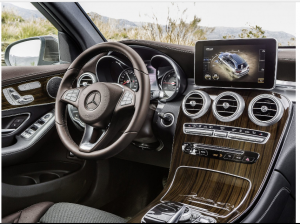
The only available Q5 engine will be a 2.0 liter turbo four.
At least the Benz is still available with a turbocharged V6 – even if the turbodiesel four is kaput.
And there’s more besides.
Including tail-out rear-wheel-drive – and a “coupe” version of this thing – to make up for the dearly departed diesel.
The GLC is a compact crossover SUV, based on the C-Class sedan and about the same overall length but with a noticeably roomier back seat, much more cargo (vs. trunk) room increased ground clearance and an up-higher (but not too high) driving position.
It comes two ways: as a conventionally crossover five-door hatchback and as a slope-roofed “coupe” – though this version still has four standard-sized doors, a liftgate out back – and (somehow) the same cargo capacity.
The regular GLC is available in rear-wheel-drive and (optionally) 4-Matic all-wheel-drive versions; the “coupe” and high-performance AMG versions of both are AWD-only.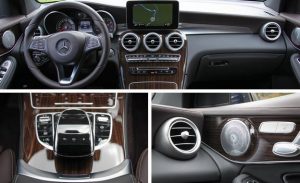
Base price is $40,050 for the rear-drive GLC300 with turbocharged 2.0 liter four cylinder engine. Adding the optional 4-Matic all-wheel-drive raises the MSRP to $42,050.
The high-performance AMG GLC 43 version comes with a turbocharged V6 and standard 4-Matic AWD. It stickers for $56,250.
The “coupe” starts out at $46,600 with the same 2.0 liter turbo four as the regular GLC300 but AWD is standard equipment. This version of the GLC is not available with rear-wheel-drive.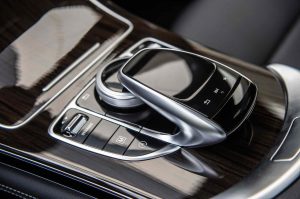
The high-performance AMG GLC 43 “coupe” with the V6 and AWD stickers for $60,400 to start.
WHAT’S NEW
The ’18 GLC lineup carries over largely unchanged – with the main change being the mournful certainty that a diesel-powered version will not be offered in the U.S.
The C-sedan’s good looks but better packaging; more room for passengers and cargo.
Drives – and handles – more like a luxury-sport sedan than a crossover SUV.
Two bodystyles – and the “coupe” has the same passenger space and cargo capacity as the regular GLC.
Rear-drive version available, which may not be great for snow driving but gives this crossover a sport sedan driving feel that its AWD-only (and often FWD-based) rivals can’t match.
Turbocharged gas engine produces diesel-like torque at diesel-like low engine speed.
A 302 hp V6 used to be standard.
Less cargo room than BMW’s X3 has.
Less ground clearance than the BMW X3, Audi Q5 and other luxury crossovers have.
A $6,550 price bump if you want the “coupe.”
It’s too bad about the diesel.
How much does 3-4 MPG matter?
Unfortunately, it matters a lot. Maybe not to customers – the people buying the cars – but then, they increasingly have little to say as far as what’s under the hood of the cars they buy.
Uncle, on the other hand, has a lot to say – and he backs up his wants with guns.
And what he wants – what he demands – is that cars use less gas . . . no matter how much it costs us. In coin – and horsepower. This is why Mercedes had to nix the 3.5 liter V6 that was standard in the GLC’s predecessor (the GLK) and replaced it with a much smaller – but turbocharged – 2.0 liter four that gets slightly better gas mileage but also happens to produce a bunch less horsepower.
The GLK’s V6 made 302. The GLC’s 2.0 liter turbo four makes 241.
But – hey now! – the GLC’s turbo four rates 22 city, 28 highway (for the rear-drive version) while the “gas guzzling” V6 only managed 18 city, 25 highway. You will have to decide whether the sacrifice of 61 horsepower for the sake of 3-4 MPG was a bargain worth making. And it’s unfortunate no one asked you, either.
On the upside, the gas turbo four makes copious torque – 273 ft.-lbs. – and makes it at idle speed (1,300 RPM).
As it happens – and this is probably not a coincidence – the turbo four’s torque number is exactly the same as the old V6’s torque number (also 273 ft.-lbs.) but the V6 needed to spin to 3,500 RPM before it reached that peak. No doubt what Mercedes was striving for – and has largely achieved – was to replicate the driving feel of the old V6, especially in stop-and-go driving – while squeeeezing out a small handful of MPGs to get that insufferable old man in the red, white and blue costume off their backs.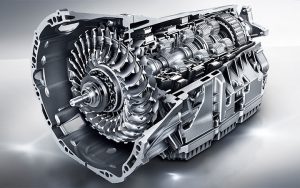
A nine-speed automatic is paired with the four (vs. the six-speed used with the old V6, again for reasons of fuel economy uber alles) and you can go rear-drive or (optionally) all-wheel-drive.
The loss of cylinders (and horses) notwithstanding, the GLC is among the quickest of the compact crossovers with its standard engine – hustling to 60 in just over six second flat. This edges out the BMW X3, which has a slightly less strong turbo 2.0 liter four (240 hp, 260 ft.-lbs. of torque).
It gets to 60 in about 6.3 seconds.
The Audi Q5 can match the performance of the standard-engined Benz, but if your need for speed is greater, Audi’s got nothing else to offer. The 2018 Q5 comes only with a 2.0 liter turbo four. It’s a bit stronger (252 hp) than the GLC’s four – but the GLC is also available in AMG form and with a 362 hp turbo’d V6 that also makes 384 ft.-lbs. of torque.
So equipped, the AMG GLC blasts to 60 in 4.8 seconds.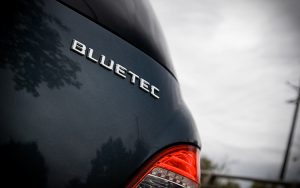
All of this is good.
It’s just too bad about that BlueTec turbodiesel four. It made 200 hp and 369 ft.-lbs. of torque (almost as much as the AMG’s turbocharged gas V6) but at just 1,600 RPM and while it wouldn’t get you to 60 in less than 5 seconds, it would take you 33 miles on a gallon of fuel – about ten miles farther (on average) than the AMG-amped GLC’s turbo-gas V6 could travel.
You can thank Uncle for its disappearance before it even got here.
The GLC is a crossover SUV but it feels – and drives – very much like the C-class luxury-sport sedan it’s based on. You sit higher up than in the C but the GLC is not jacked up. The Benz – which stands 64.7 inches tall and has 5.9 inches of ground clearance – is almost in the weeds compared with cross-shops like the BMW X3 – which stands 66.1 inches tall and has 8.3 inches of ground clearance.
Another cross-shop, the Audi Q5, has 7.9 inches of clearance.
These higher-riders are a bit more snow-day capable as a result . . . if you ever have to deal with unplowed snow that’s more than six inches deep. On the other hand, they are also more top-heavy all the time – which you’ll notice in the curves. The Benz – its weight being several inches closer to the pavement – hugs the road better; there’s less body roll at high speeds than higher-riding crossovers.
Another rival in this segment – the Porsche Macan – offers adjustable ride height that can be varied from 7.5 inches to a little over nine. It – being a Porsche – also corners as well as it deals with snow days. It is hard to fault. But the Macan is effectively a four seater because of its second row center console/hump- while the Benz will honestly carry five people. The Porsche is also in a higher price bracket: $47,500 to start and pushing $90k loaded. For the latter sum, you could buy the AMG version with everything and still have enough gas money left over for the next four or five years.
Also, the Macan comes only in AWD form. The Benz is available with AWD – but offers a rear-drive version. Which you may prefer – and not just because it’ll save you around $7,500 vs. the least expensive version of the Macan.
AWD gives you more traction – but RWD is arguably more fun. Precisely because it’s easier to break traction. You can turn off the TCS and let the rear end slide around a little bit, controlling the sliding with your right foot. AWD eliminates the possibility of this, which arguably takes away something from the driver – and the art of driving. In a rear-drive car, there’s a challenge in modulating throttle to keep on the edge of traction while maintaining control; in getting up a slick road using skill that lesser drivers couldn’t deal with unless they had the crutch of AWD.
AWD is an equalizer and a leveler. It also adds weight, of course – and that slows the car down. Not hugely, but it’s noticeable. And, of course, there is the additional hardware to buy – and maintain and service.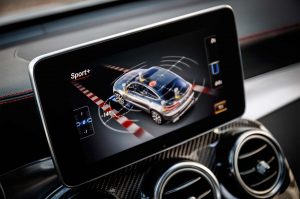
The new turbo four has less horsepower but the GLC is about as quick as the old V6-powered (and more powerful) GLK. Horsepower having been made up for by less curb weight.
The four cylinder GLC weighs 3,891 lbs. vs. 4,068 for the old GLK.
The turbo four’s torque is on tap sooner, too – so the GLC actually feels stronger at first – its lesser horsepower notwithstanding. That swell of instant-on torque is one of the real benefits of these new turbocharged fours – despite Uncle’s worst intentions.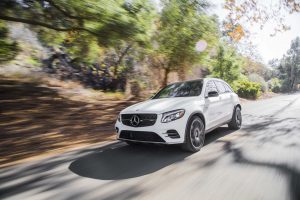
There is also a new nine-speed automatic (like the turbo four, it is there for reasons of fuel economy uber alles) but unlike some of the other more-than-six-speed transmissions on the market, this one doesn’t jump around like a tick put on a hot stovetop. The transitions in between all those gears is smooth and ordered; very gleichschaltung.
You can configure shift action as well as throttle tip-in and other parameters individually or grouped together under Comfort, Eco, Sport or Sport+ settings.
One of the neat things about the GLC is that you can pick a bodystyle. Traditional crossover SUV profile . . . or “coupe.” It’s not a two-door, of course. But the idea is to emulate the aesthetics of one. This part is doable enough. Mercedes was among the first to do it with the CLS “coupe.”
The usual problem is that by doing it, interior (and in the case of a crossover, cargo) room is usually compromised.
Mercedes managed to keep most of the standard GLC interior specs the same – or at least, close – while considerably changing the GLC’s “coupe’s” exterior profile.
Cargo capacity behind the second row is – somehow – identical in both: 18 cubic feet in both. And with the second row folded, the same 56.5 cubic feet.
Hat tip, sirs.
Front and rear legroom (40.8 inches and 37.3 inches, respectively) are also the same in the standard GLC and the GLC “coupe” but not the same as in the C-Class sedan, from whose loins – so to speak – the GLC sprang. The C-Class has a bit more front seat legroom (41.7 inches) but noticeably less second row legroom (35.2 inches).
Another measure – headroom – is more generous in the regular GLC than in the C sedan, especially (again) in the second row. The GLC has 38.5 inches of headroom vs. 37.1 inches in the C sedan. Even the GLC “coupe” – with its snarkier roofline – has a more tall-person-friendly 37.6 inches of second row headroom.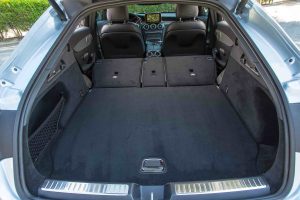
In a nutshell, the GLC – while still technically a compact-sized crossover – is mid-sized car roomy without the larger exterior package. It fits better in parking spots, takes up less room in the garage – but you can carry more stuff (and people more comfortably) than in a compact sedan like the C-Class.
This – along with the up-higher driving position and better-in-snow-capabilities – explains why crossovers have become so popular and not just the high-end ones like this one.
There’s a lot of features overlap between the GLC and much more expensive Mercedes models. Meaning, Mercedes lets you buy high-features – such as the GLC’s optional and superb 14 speaker Burmester surround sound audio system and an in-car scent spritzer – that are also found in Mercedes’ top-of-the-line models like the S-Class sedan.
But you don’t have to buy the six figure S-Class to get them.
Other GLC options include a Heads-Up Display (HUD), an adaptive air suspension and a gorgeous iPad-style 8.4 inch LCD display that’s very similar to the one in the $100,000 S-Class sedan. It’s controlled by a smartphone-style swipe/tap touchpad on the center console.
Almost all of these optional features come standard in the AMG version of the GLC – which also gets a 20-inch performance tire package, high-performance brakes and unique “AMG” trim accents.
But it’s a shame about the BlueTec.
Ach, Rudy. We hardly knew ye… .
THE BOTTOM LINE
If you’re interested in riding higher – but not too high – the GLC is one you’ll want to check out.
If you like what you’ve found here, please consider supporting EPautos.
We depend on you to keep the wheels turning!
Our donate button is here.
If you prefer not to use PayPal, our mailing address is:
EPautos
721 Hummingbird Lane SE
Copper Hill, VA 24079
PS: EPautos stickers are free to those who send in $20 or more to support the site. Also, the eBook – free! – is available. Click here. Just enter you email in the box on the top of the main page and we’ll email you a copy instantly!


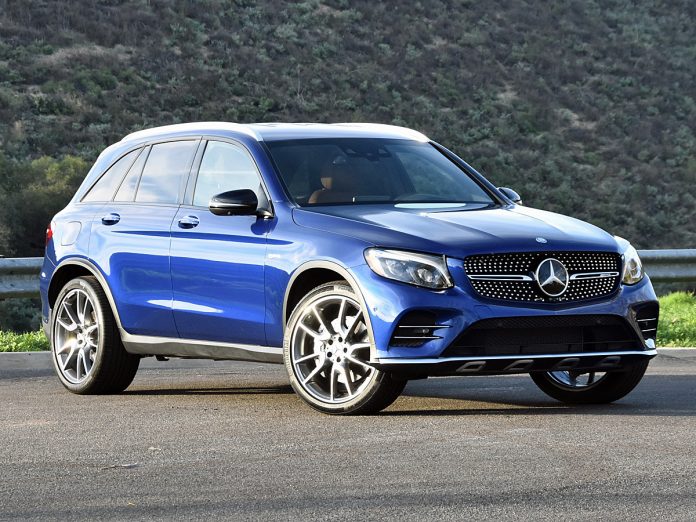

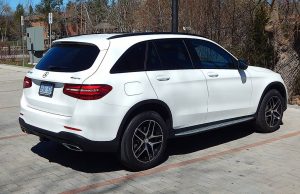
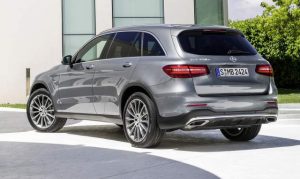
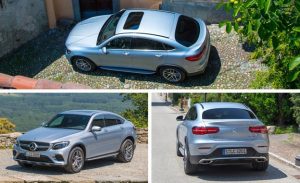



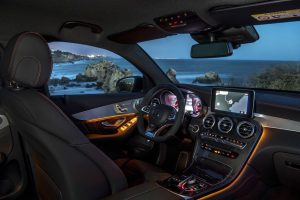







I test-drove a GLK with the Bluetec diesel – it was a fantastic motor for city driving. You could point & shoot your way through traffic with only a gentle press of the tall pedal.
Something else I miss about the GLK is the body shape. The boxy outline meant you could haul bigger stuff. Like a new flatscreen TV – something the GLC would have a real problem with because the hatch area slopes downward. Never mind the awkwardly shaped GLC Coupe.
Hi Chip,
Yup. Big fan of the Bluetec here as well. It’s depressing what’s being done to diesels generally. I racked my brain to understand why… and it only makes sense if the issue is that diesel engines work too well and thus must be stomped.